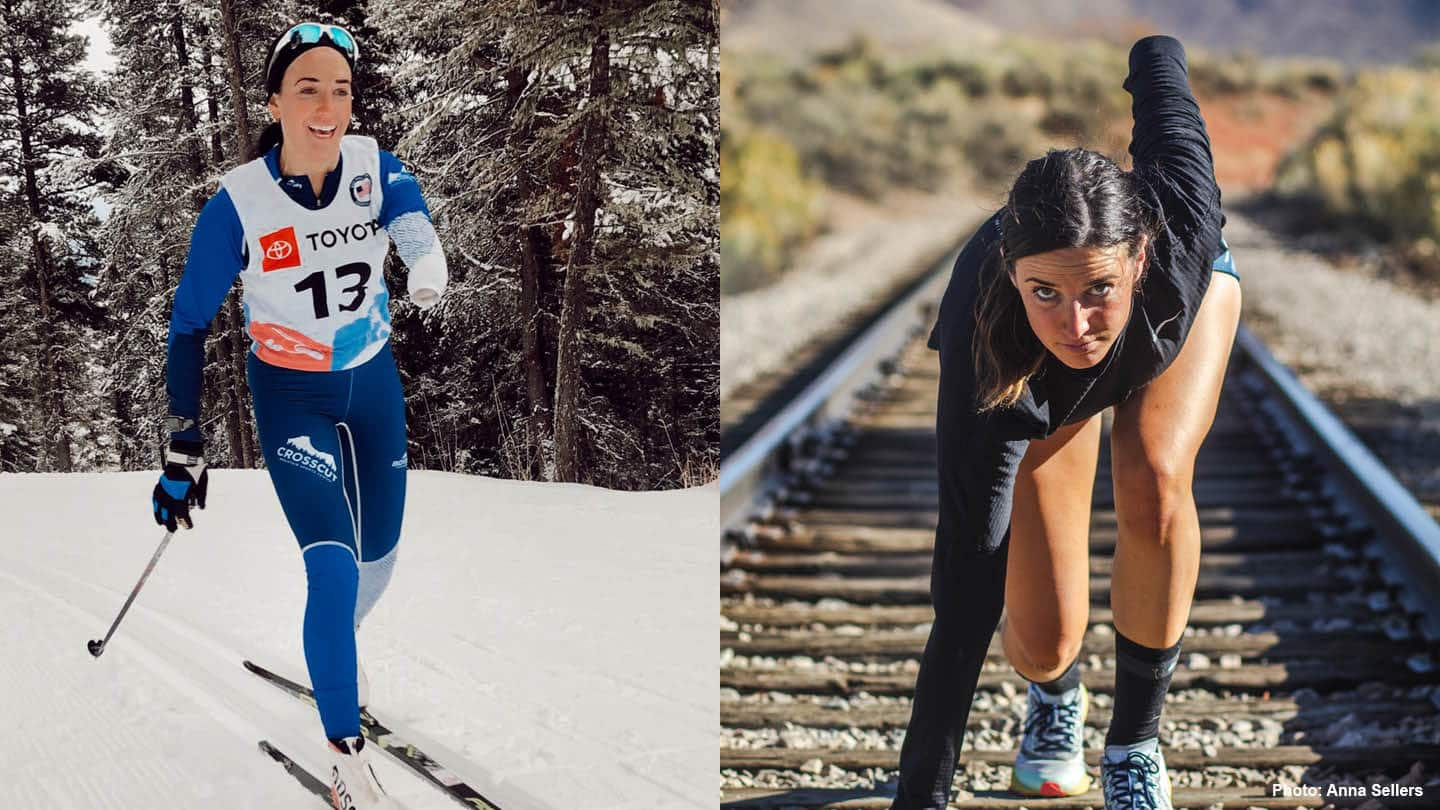
Para 101: Why Do Runners Make Good Nordic Skiers?
by Alex Abrams

Dani Aravich skis, left, and poses in a running starting position, right.
BethAnn Chamberlain has spread the word about Para Nordic skiing at track meets and other running events for adaptive athletes.
Chamberlain, the development coach for U.S. Paralympics Nordic Skiing, often speaks with visually impaired runners or those with a limb impairments to see if they might be interested in getting on a pair of skis.
Chamberlain has found that athletes with a running background often make a smooth transition to Para Nordic skiing. She said runners, especially distance runners, have a similar mindset and body type as cross-country skiers.
Athletes in both sports are accustomed to pushing through nagging injuries to finish races that cover long distances. And it doesn’t hurt that the classic technique in cross-country skiing is similar to a running stride.
“If someone has a really good engine, even if their (skiing) technique isn’t the best to start and that takes a long time to develop, athletes can run on skis and often do as they’re learning because that’s what they know,” Chamberlain said.
“They can progress. They get a feel for it. They have to continue to develop their own ski-specific technique, but that crossover is helpful. I think it helps people feel familiar.”
Several athletes who compete for U.S. Paralympics Nordic Skiing are multi-sport stars, including some with backgrounds in track and field.
Standing skier Dani Aravich and visually impaired skier Max Nelson are relative newcomers to Para Nordic skiing. They got started as runners, but they’ve developed enough in skiing to represent Team USA at a world cup event in Slovenia this past winter.
Aravich ran cross country at Butler University, and she hopes to qualify in the 400-meter dash at this summer’s Tokyo Paralympics. Nelson, meanwhile, runs for his high school cross-country and track-and-field teams.
“Skiing gives you a lot of endurance, and it helps a lot with running, too,” Nelson said. “It’s like a win-win situation.”
Liza Corso started Para Nordic skiing after Chamberlain heard about the teenager’s running background and invited her to a ski camp in Breckenridge, Colorado, in December 2019.
Corso, who was born with albinism that causes her eyes to be sensitive to light, is considered one of the top high school distance runners in New Hampshire.
In November, Corso signed a national letter of intent to run track and cross country at Lipscomb University, an NCAA D-I school in Nashville, Tennessee.
In March, she competed in her first biathlon competition at the U.S. Biathlon National Championships in West Yellowstone, Montana.
“At first, I was a little hesitant just because I was pretty busy with running,” Corso said about her decision to start Para Nordic skiing. “In high school, I was just getting a little more serious.
“I was definitely a little hesitant at first, but I love skiing and I love the endurance aspect of running. And so I thought it would be fun, and it would be a new challenge.”
Distance runners, with their lean, strong frames, tend to have similar body types as standing and visually impaired skiers. They don’t usually have the big muscle mass that athletes in such winter sports as the bobsled and luge have.
Para Nordic skiers train year-round, but since they can’t actually ski on snow for much of the year because of the weather, they must find other ways to maintain their conditioning. One way they stay in shape is by running.
“We’re cross-training, so whether you’re a ‘runner’ or not, pretty much everyone (runs), for standing and visually impaired athletes for us,” Chamberlain said. “Running is a component of training no matter what. That is a training mode that we all use.”
Chamberlain said Nordic skiing is more technical than running. She added that skiers use their upper bodies more than runners as they propel themselves across the snow with their ski poles.
Still, runners and skiers seem to have the same mental makeup, which helps them go back and forth between the two sports.
“They’re both tough sports, right? They require a good amount of mental toughness and kind of being comfortable with being uncomfortable in that funny, endurance fun kind of way,” Chamberlain said.
“There are more technical aspects of (skiing) versus running, but you still have to put the training in, be a little uncomfortable with some training sessions and push at that high end, kind of settle into the pain cave, I would say, for both sports. And because of that, we see that crossover. Those characteristics in runners often carry over into skiing.”